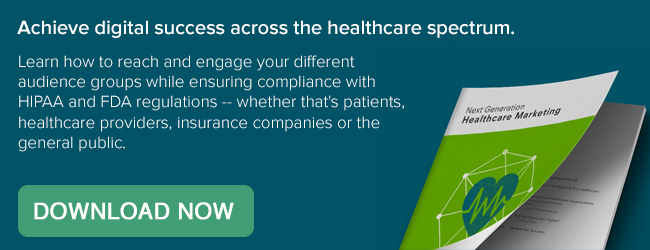
When we talk about data analytics and measuring ROI, there are several standards that we use to categorize success—website visits, number of new contacts and revenue gains or losses. These are all helpful metrics and should be taken into consideration in any marketing report. However, there are loads of different ways to measure success in digital marketing, and success looks different from industry to industry—particularly in the healthcare industry.
If you’re in healthcare, the majority of your marketing efforts are likely focused on gaining and keeping new patients. In order to effectively evolve your digital marketing strategy over time, your data analysis should also focus on customer (patient) acquisition and retention.
Here’s a breakdown of the top 7 metrics you should be analyzing on a regular basis.
1) Patient Acquisition Cost
This is probably the most relevant metric, as your whole marketing budget will be based around this number. How much does it cost to acquire a new patient? Take into account that different sources – referrals, paid search, social media, etc. – may have different costs per lead, but that all are valuable ways of generating new patients. Don’t forget to factor in the lifetime value of a patient, in order to see the full view. It may seem like a lot to spend $500 per acquisition, but if the patient’s lifetime value is over $10,000, then the initial investment is worth it.
How to calculate:
Traditional marketing would have you divide all the costs for marketing within a certain period of time by the number of new patients acquired. This method, though, only gives you a surface-level look and it doesn't allow for a deep analysis into which activities are most effective at bringing in new patients. However, with digital marketing, you can actually track a lead from a PPC ad to a landing page conversion to becoming a patient. Or, from a social post to a “Contact Us” form submission to becoming a patient. Each of these activities will have different costs-per-customer and will allow you to see where you need to allocate your budget based on what’s most effective in your market.
2) Patient Retention
It’s not enough to gain a lot of new patients—you need to keep them coming back. One loyal patient will do more good for your bottom line than 10 new patients. Loyal patients not only spend more over their lifetime, they also are great brand evangelists and will likely recommend you to their friends and family if you continue to delight them with your treatment and services. In your analytics, be sure to highlight returning patients.
How to calculate:
To calculate patient retention rates, you'll need to know how many existing patients you have and how many you gained or lost over a set period of time. If math isn't your thing, Inc.com has a great formula to easily calculate your retention rate.
3) Customer Service Response Time
This is a metric that often trips healthcare organizations up. Customer service is for shopping, right? Wrong. Great customer service is the best way to make your healthcare organization stand out from the crowd. It’s especially important in today’s digital age as it becomes easier for complaints and bad reviews to be spread far and wide online.
Patients care about how they’re treated and their experiences at each of their appointments, but it doesn’t end there – they also care about how they’re treated outside of your office, through appointment reminders, follow-ups and response time to their questions and concerns. The level of service and treatment they receive can make or break your relationship with them. Give your staff goals and don’t simply think about email and phone call response times, make sure you’re taking social media response times into account, as well. And remember, social media users expect responses within an hour.
How to calculate:
Facebook is now starting to track customer service response time for brand pages. You can also have your digital team log the time of each incoming inquiry and the time of each response.
4) Engagement
Engagement metrics are often considered "soft metrics," meaning they don’t show a definitive ROI. Yet, engagement metrics can be incredibly helpful in evaluating your overall brand awareness and message penetration into the market. Plus, with marketing automation platforms, you can attribute patients to certain sources and gain insight into how they originated in your database.
With HubSpot, for example, you can use the “Sources” report to show which social media leads became customers. You can also set up custom lead scoring to assign a certain number of points to each contact for certain actions they take – such as downloading a checklist or clicking on an email. This is another great way to measure engagement, as you can quickly see which leads are interacting with your content the most based on their score.
How to calculate:
Set up Lead Scoring in HubSpot, track leads and analyze their scores over time to see if there is an optimal score which signifies someone will soon become a patient or customer.
5) Effectiveness of Premium Content
Speaking of content, be sure to do ongoing analysis into your most effective pieces of premium content. Which ones are downloaded the most? Which ones have a higher lead-to-customer conversion rate? Knowing this will help guide your future content strategy. It can also help you pinpoint which resources should be reworked or retired.
If your checklist, “Things to Know Before Surgery,” brings you the most leads on social media, it might also be a good resource to test in PPC (pay per click) ads. If your infographic, “Top Tips for a Healthy Heart,” brought in hundreds of leads two years ago but has dropped off lately, it may be time to redesign it with fresh graphics.
How to calculate:
Track the submission rate for each landing page (percentage of views which resulted in a form submission). If you're getting a ton of views but have a low submission rate, rethink the design of your landing page or analyze whether your copy aligns with what the resource actually offers.
New content is great, and you should always be thinking about creating new premium content pieces, but don't forget to continue to optimize and refresh your existing pieces. To go even deeper, track the customer rate (the percentage of views that became customers) and run campaigns around your strongest performing content.
6) Search Engine Rankings
This is an important metric in any industry, but is especially important in healthcare, where local search ranking is key to attracting new patients. Monitor your ranking for branded and non-branded keywords relevant to your organization.
Additionally, keep your eye on each keyword’s difficulty and the number of monthly searches it collects. In some cases, there might be a keyword we like to call the “low hanging fruit” – one that has a low difficulty score and high number of monthly searches – that you can easily rank for. Then, adjust your website keyword optimization strategy as needed.
How to calculate:
There are several great tools out there which will allow you to see how you rank for keywords and how you stack up against your competition. Try HubSpot's Keyword Tool or Moz Local.
7) Overall Campaign Evaluation
Think of this as almost a mini report unto itself. At the end of each campaign, do a recap to evaluate how successful it was. Different campaigns will have different goals. Some, such as an April “Heart Health” campaign, may be more about raising awareness around an issue, so metrics to track should be engagement-based.
Others, such as a “Schedule Your Annual Check-up” campaign, may be about raising awareness and about increasing the number of scheduled appointments, so the metrics you track should be both engagement- and revenue-based. Evaluating your campaign based on your original goals will help you to determine its success, as well as make suggestions for and strategize future campaigns.
Digital marketing has opened up a vast influx of data and the trick is making sense of it all. What metrics have you used in the past and how are you adapting your analysis?
To learn more about how to reach and engage with different audiences, download our Next Generation Healthcare Marketing white paper.
from HubSpot Marketing Blog http://blog.hubspot.com/marketing/healthcare-marketing-metrics
Via http://blog.hubspot.com/marketing/healthcare-marketing-metrics

No comments:
Post a Comment